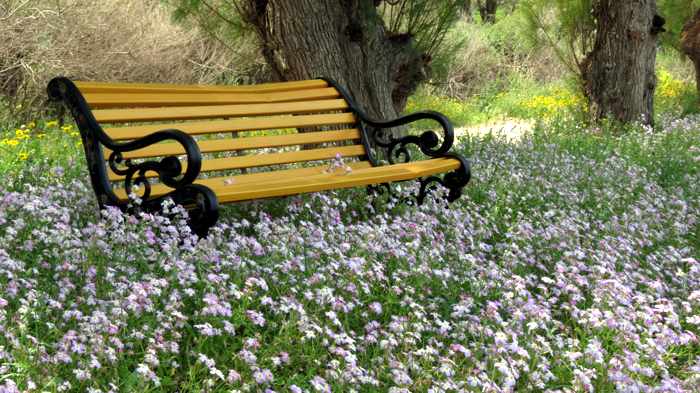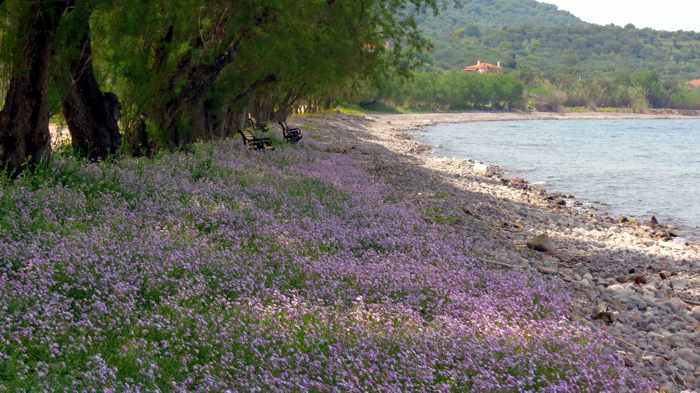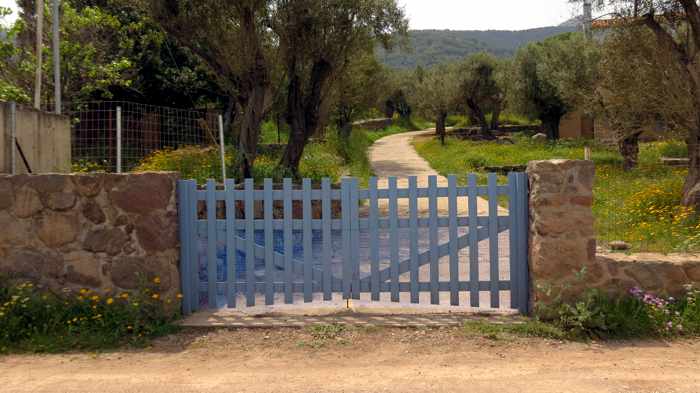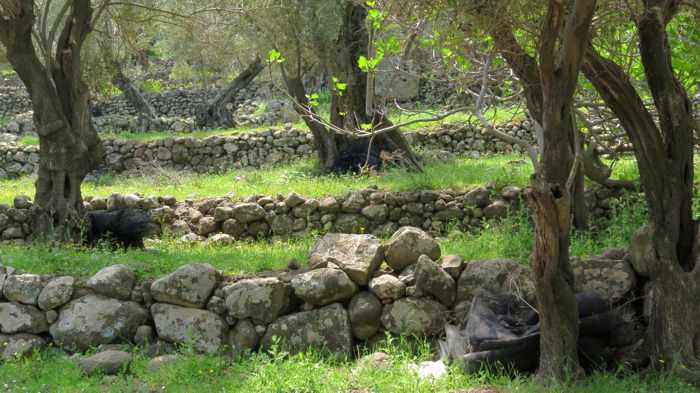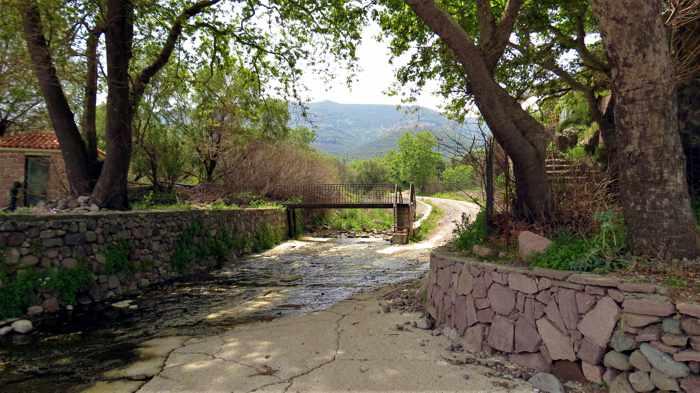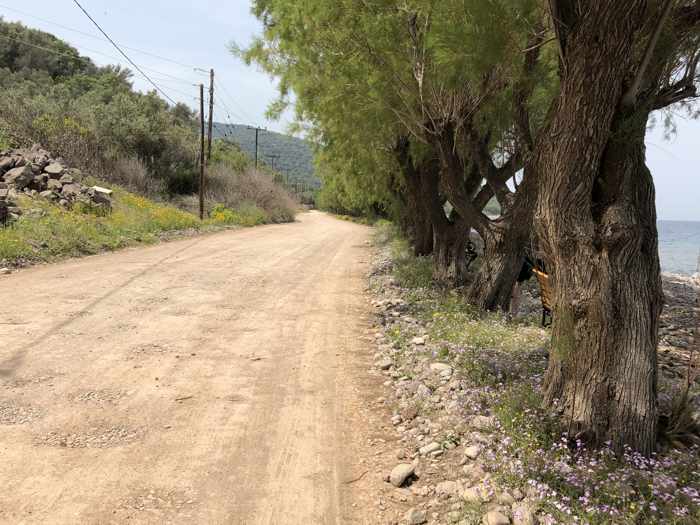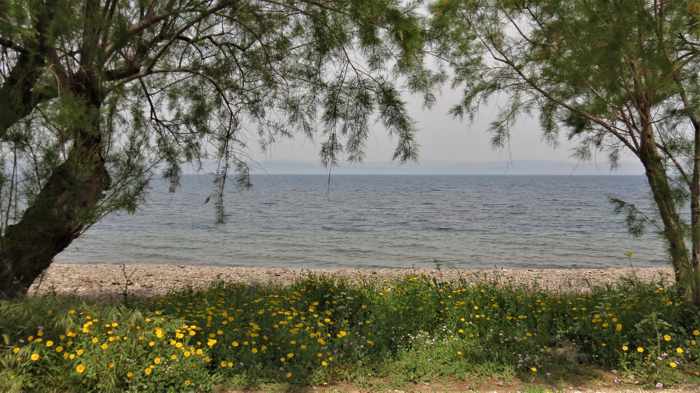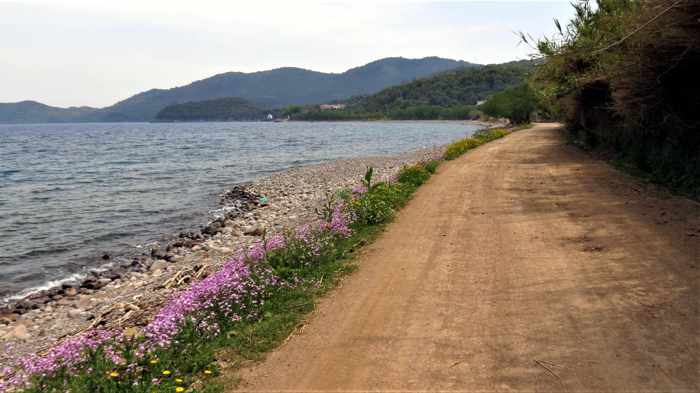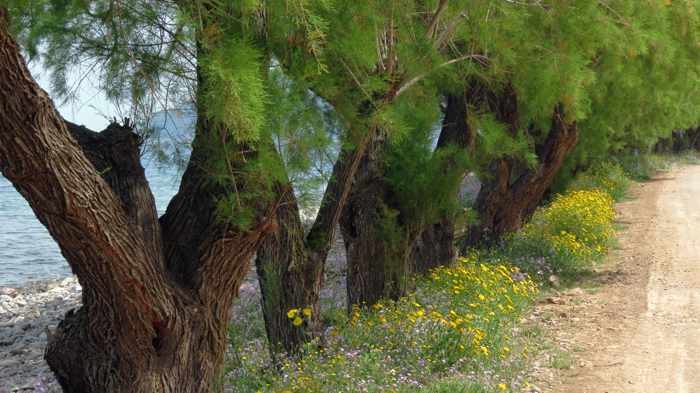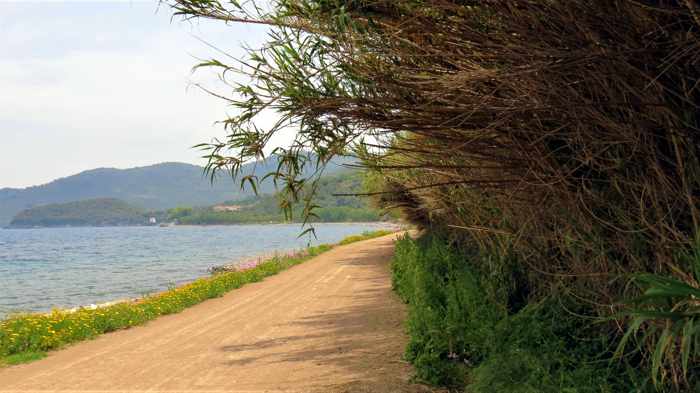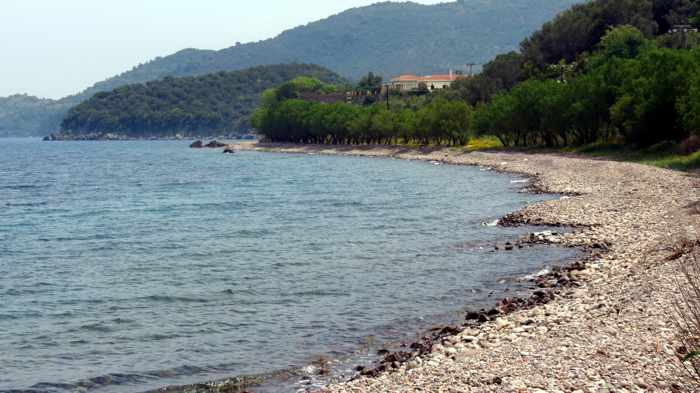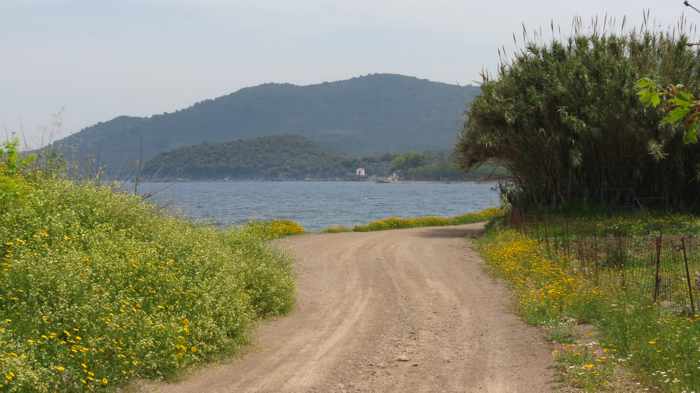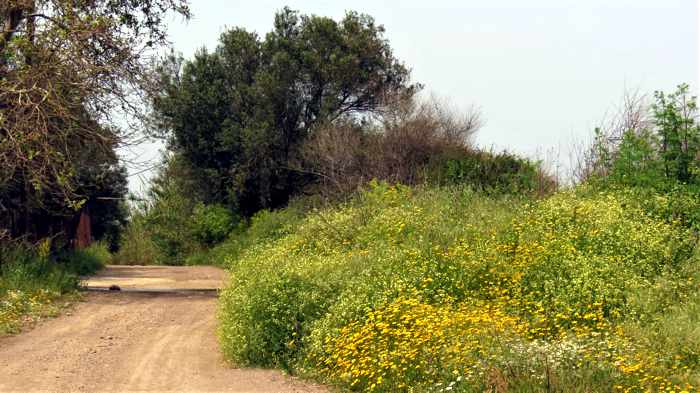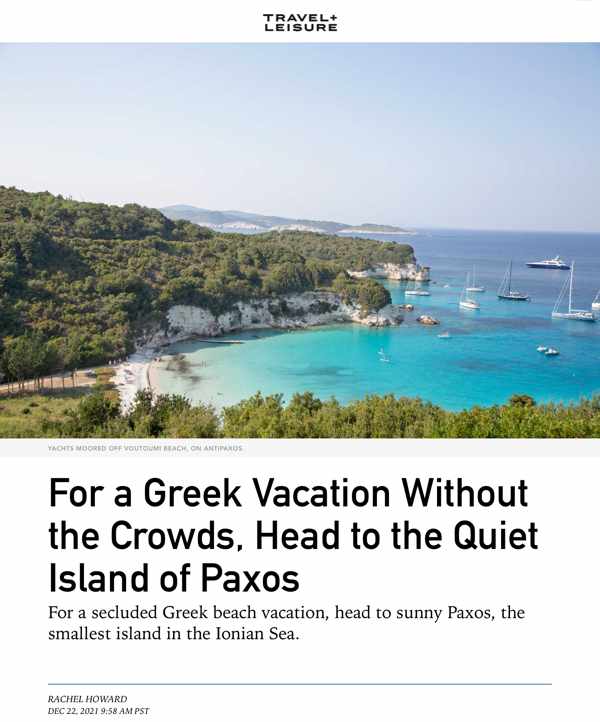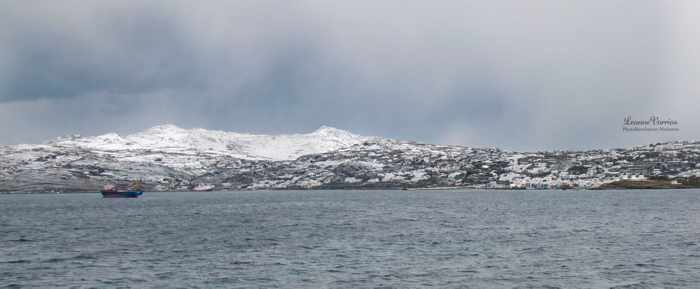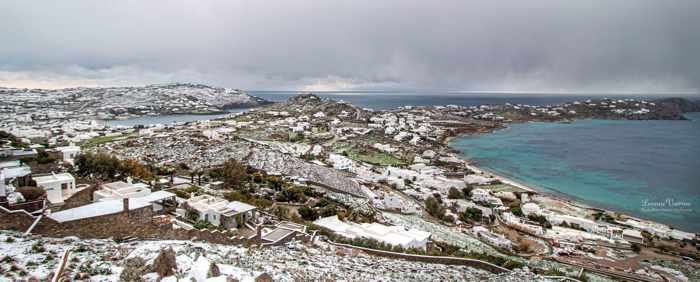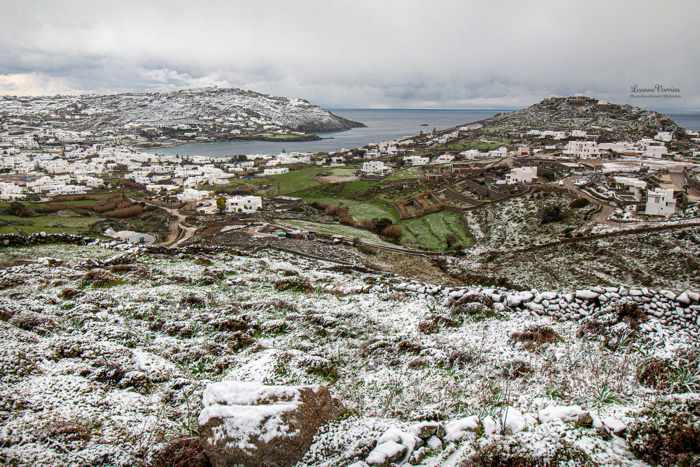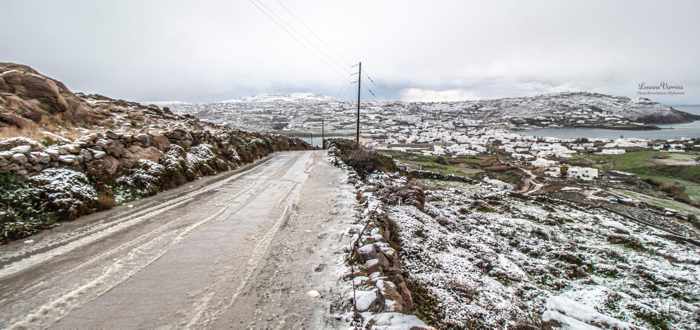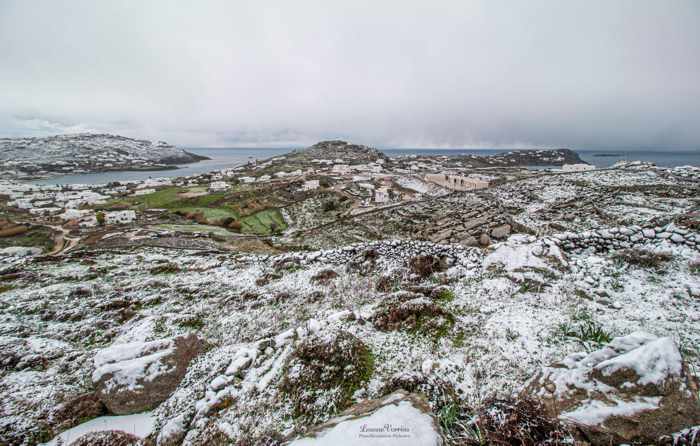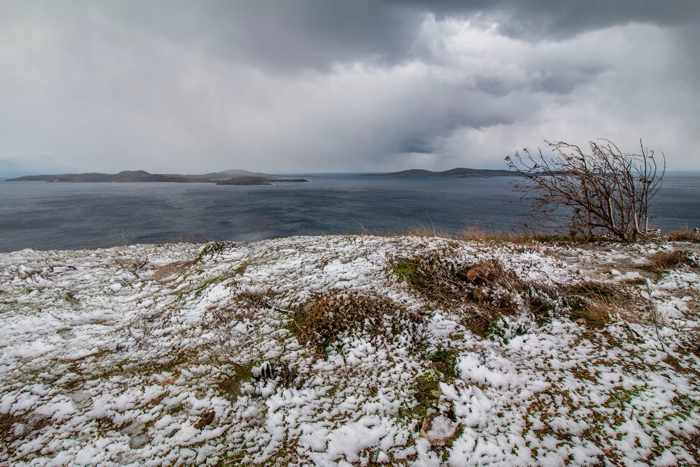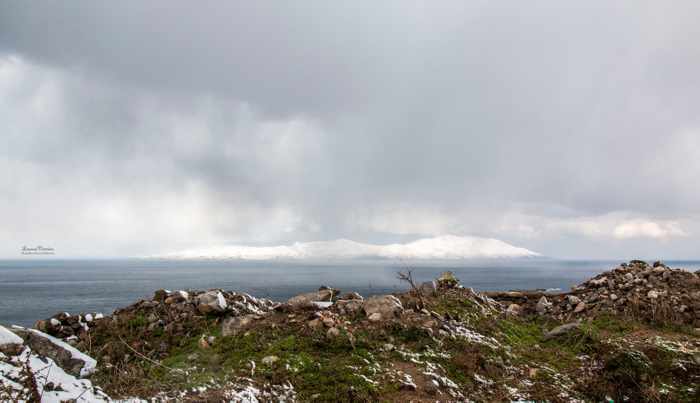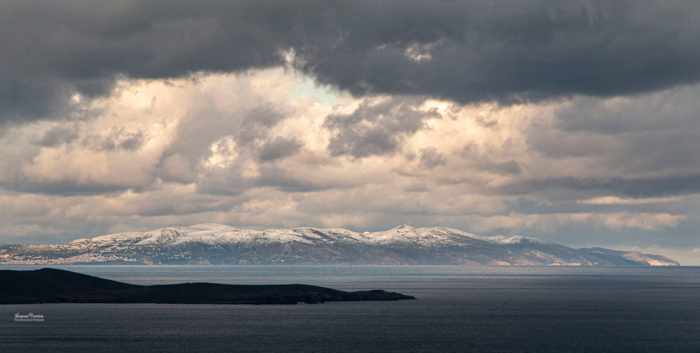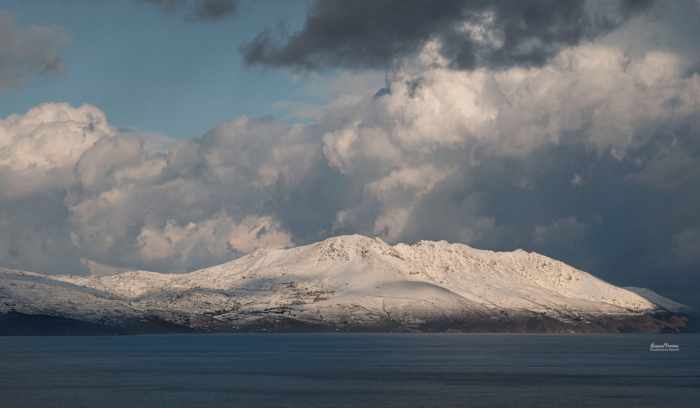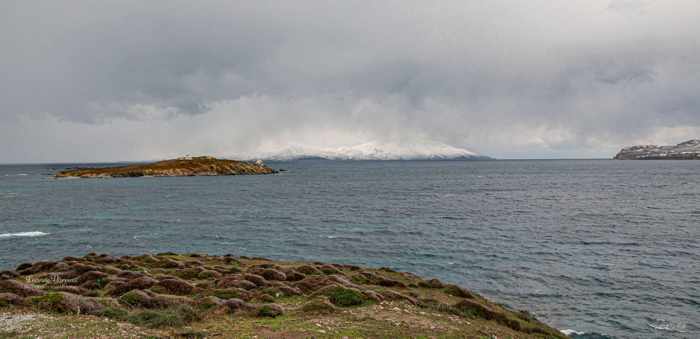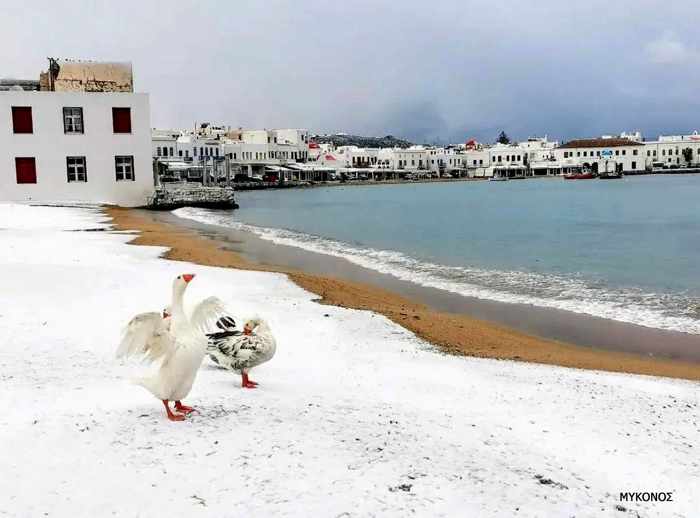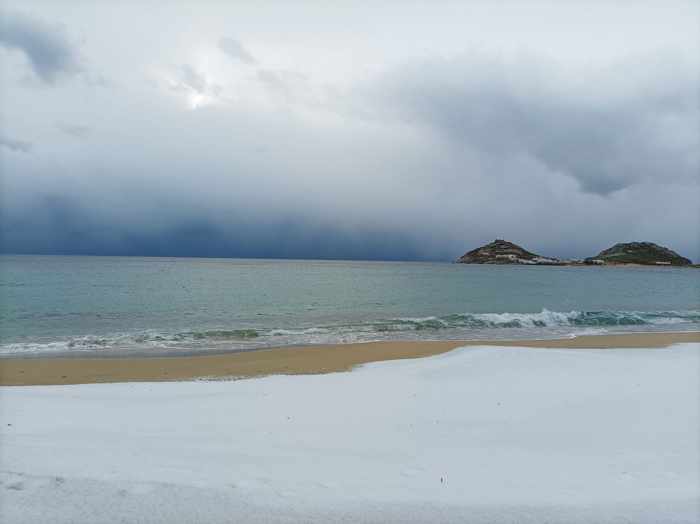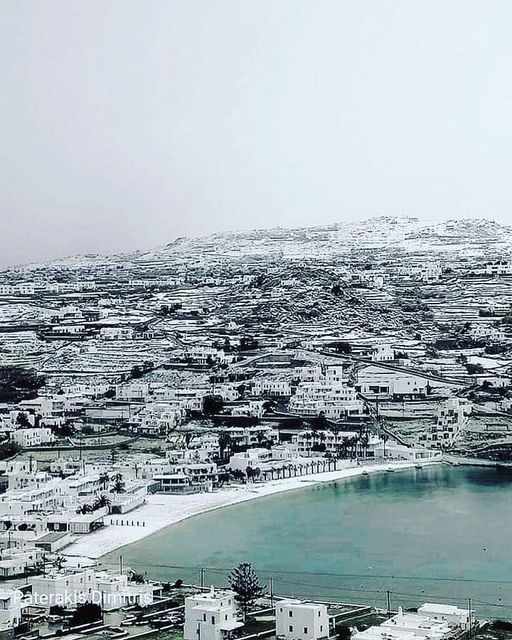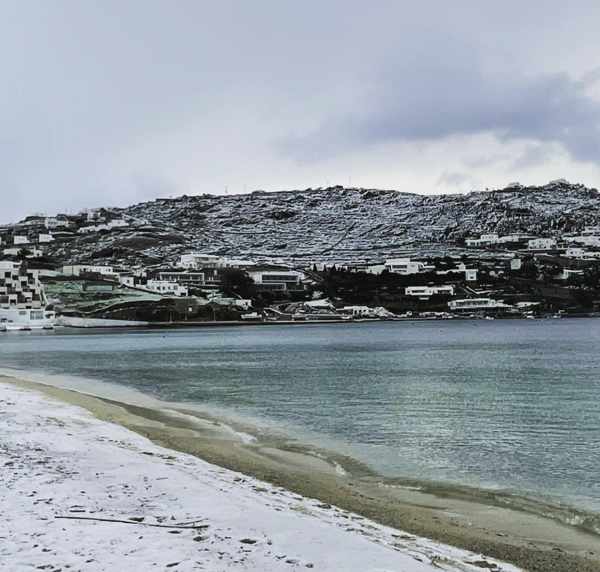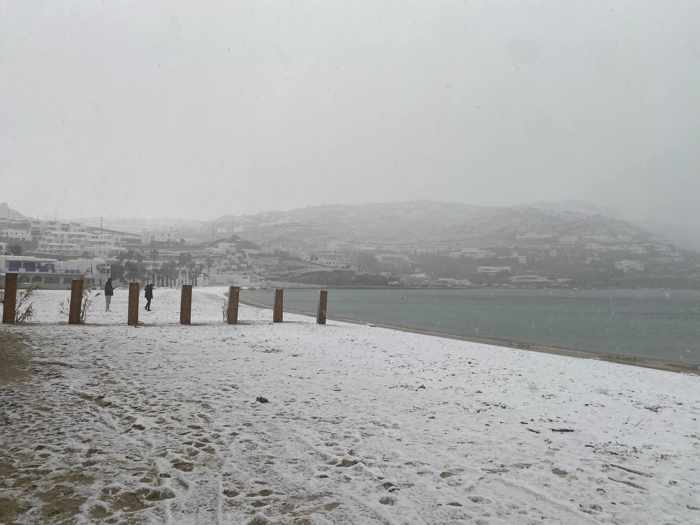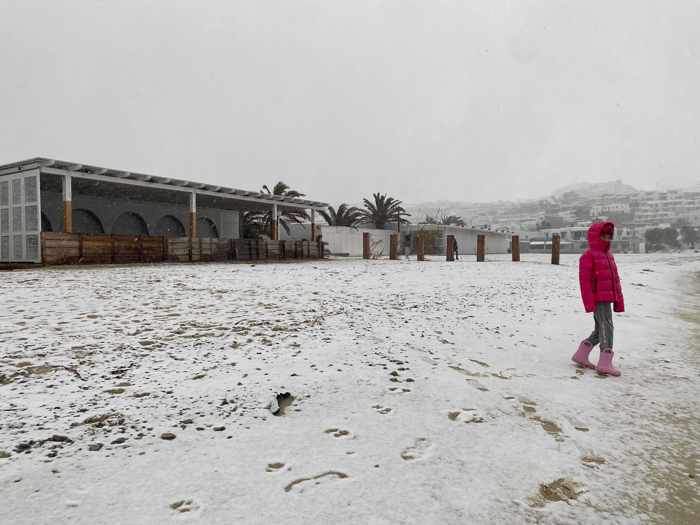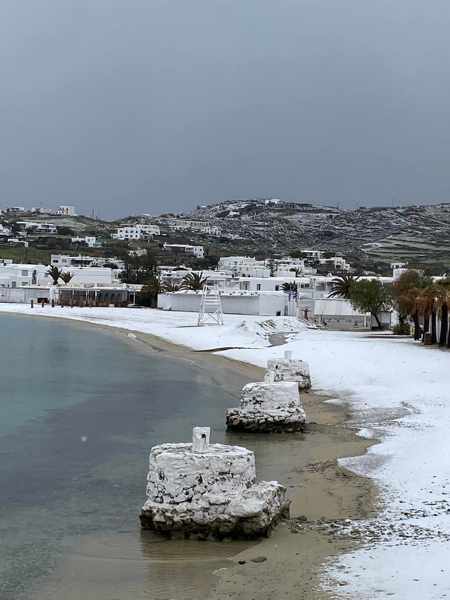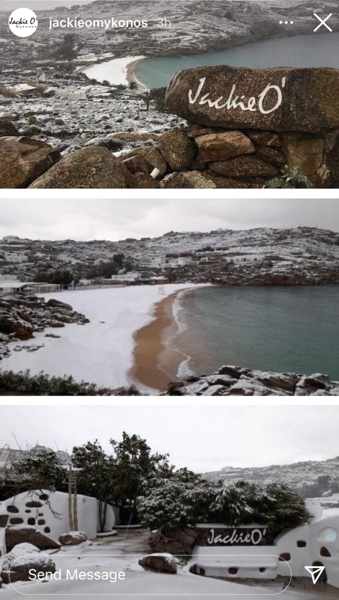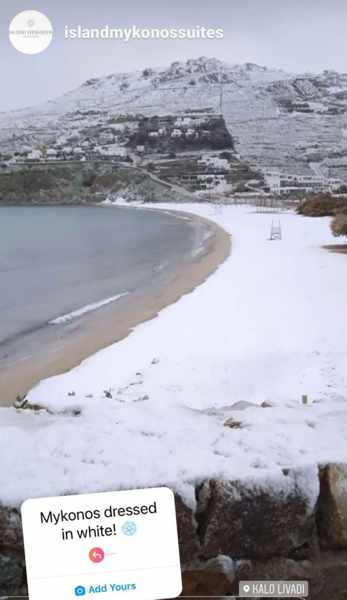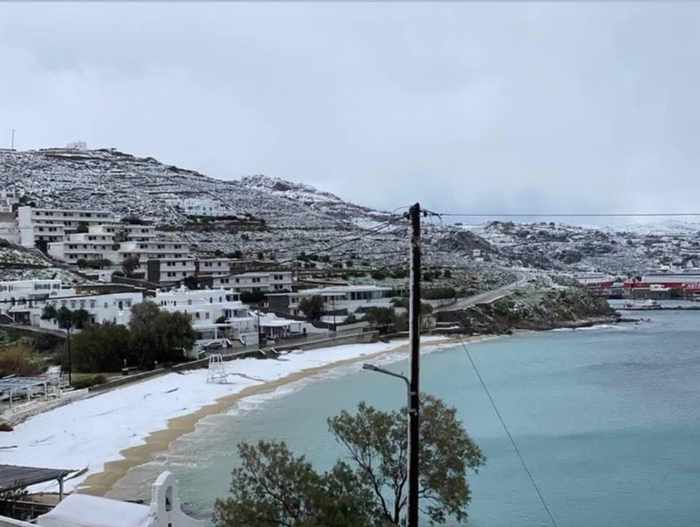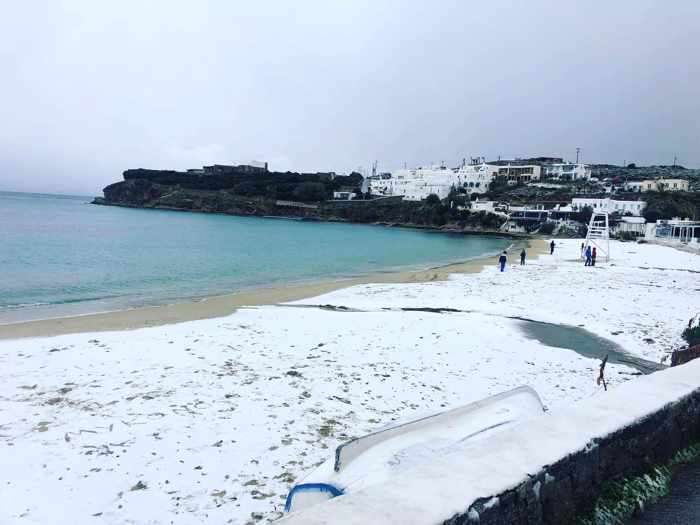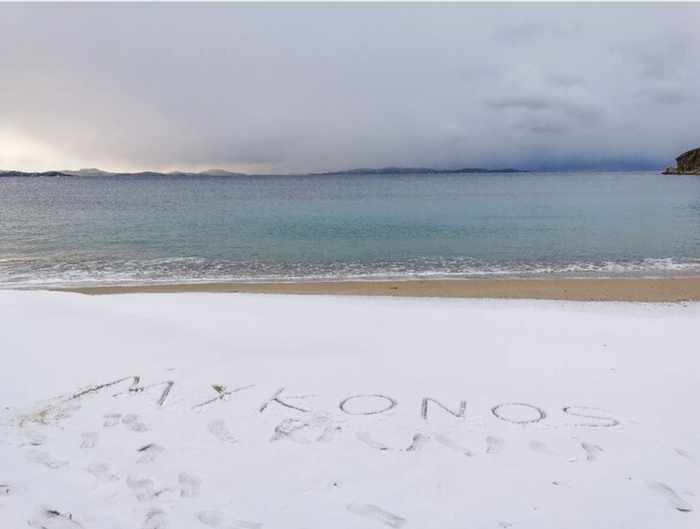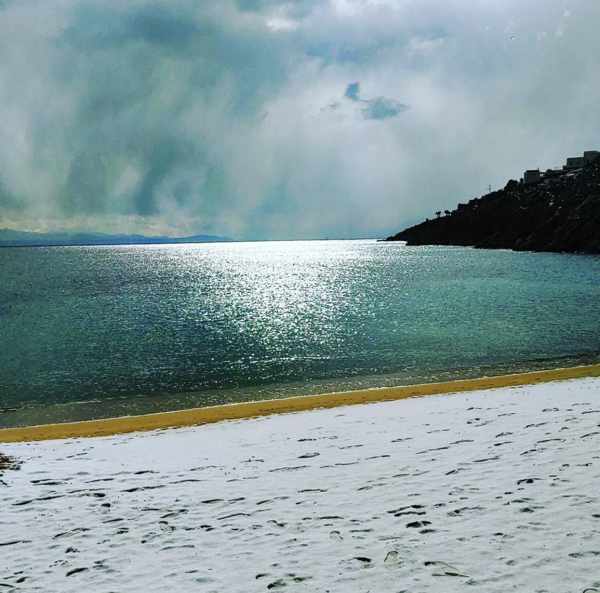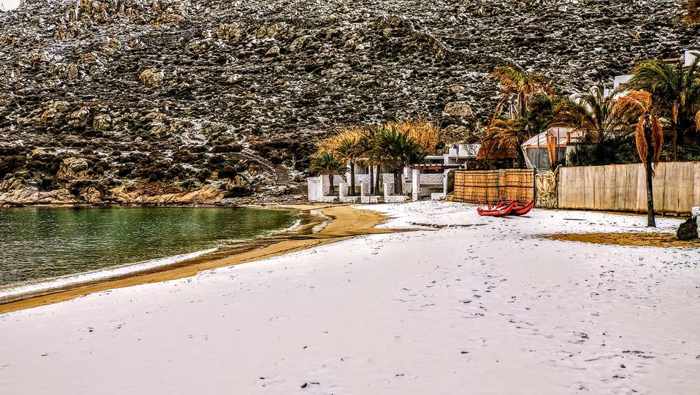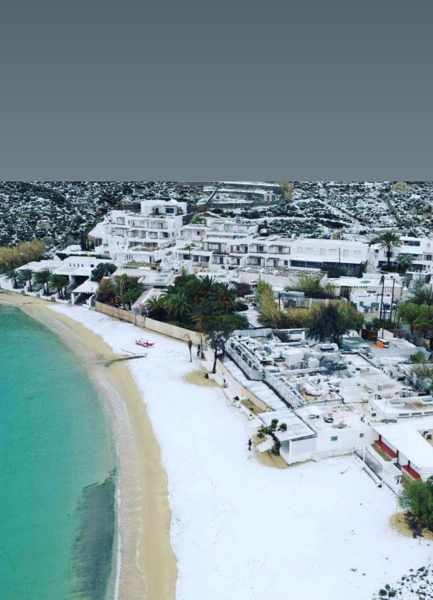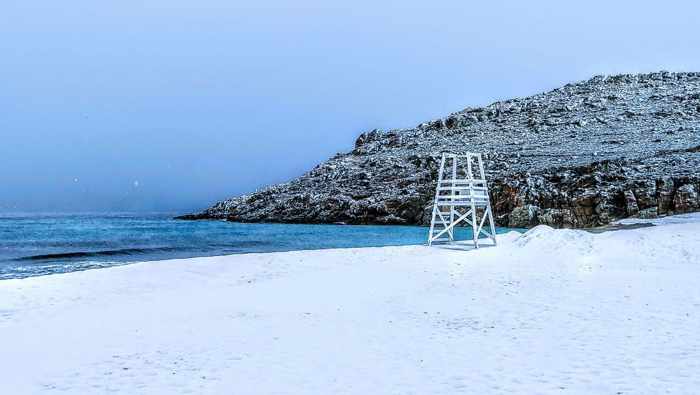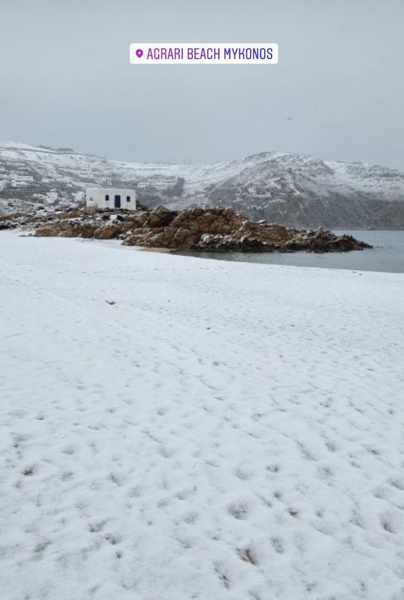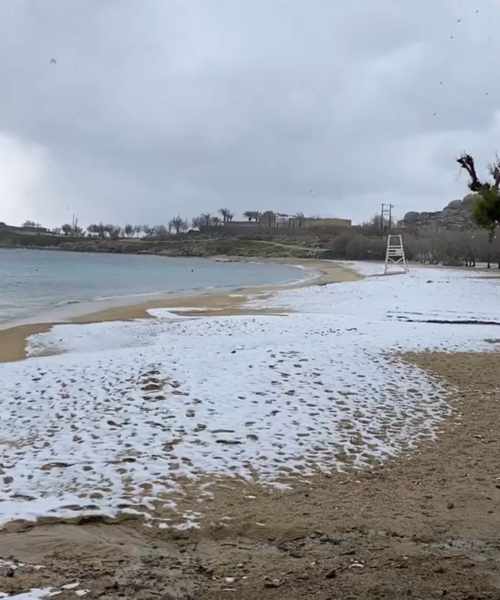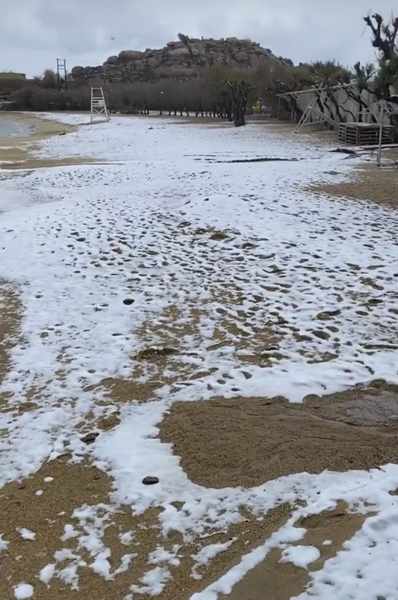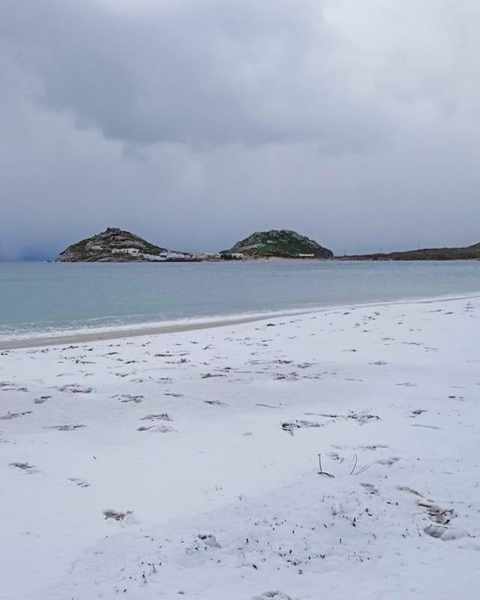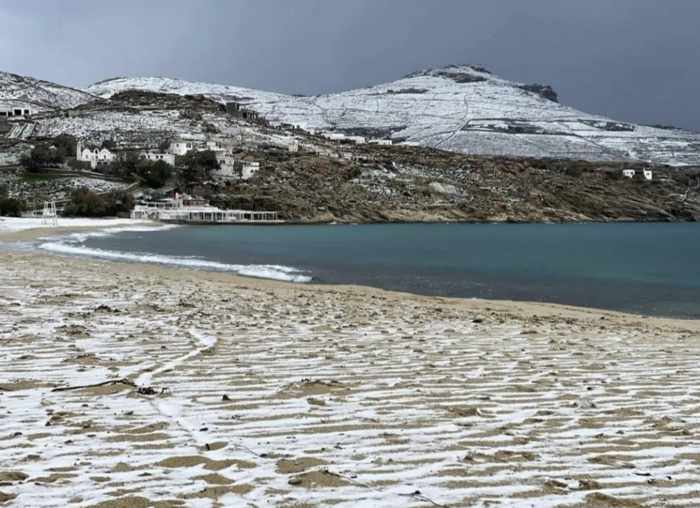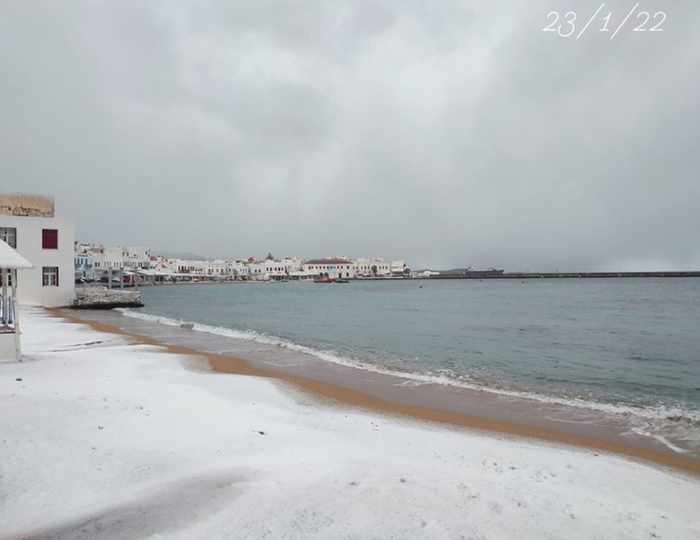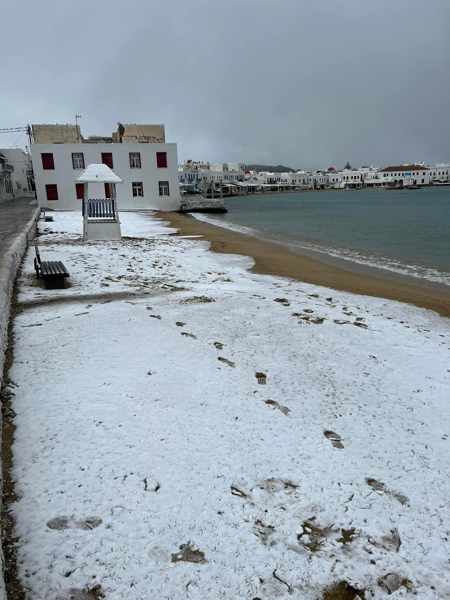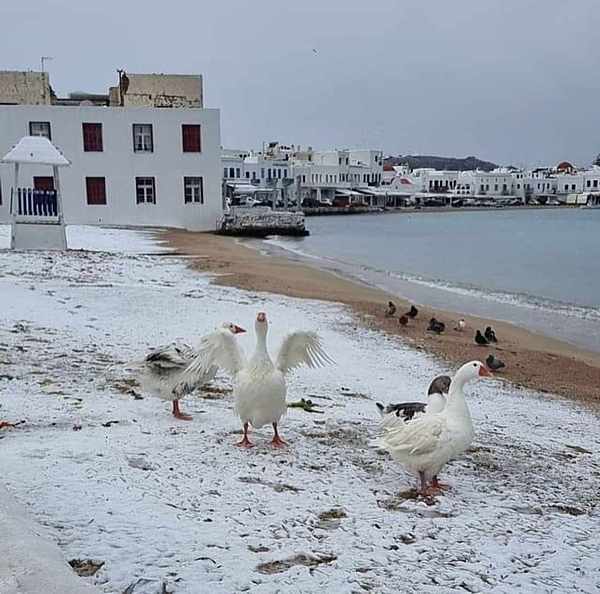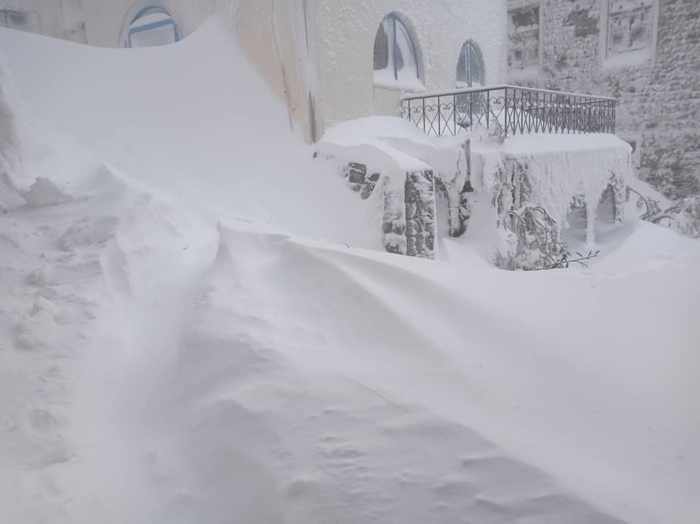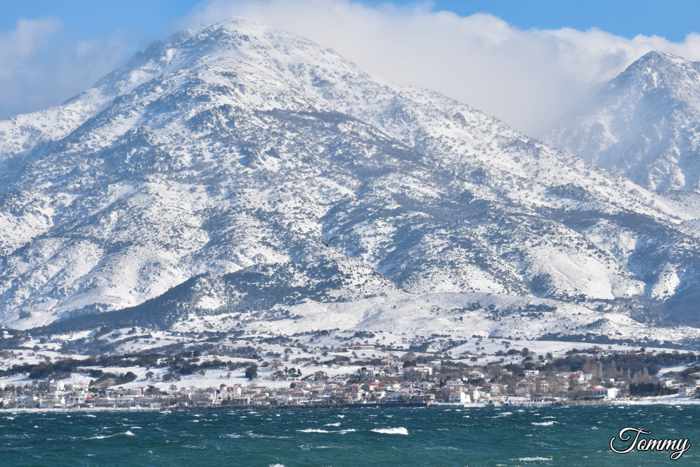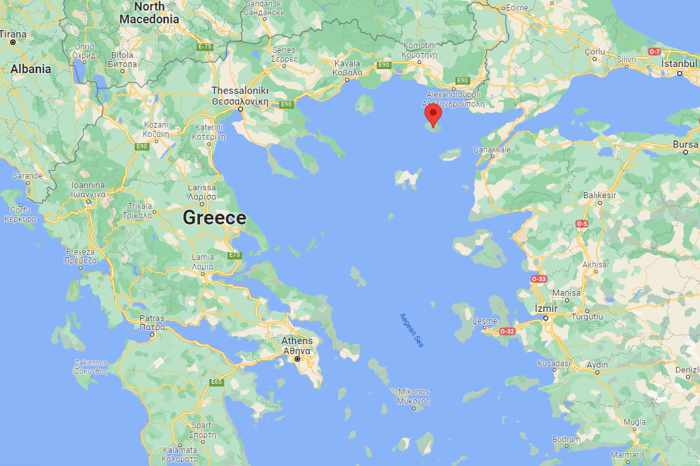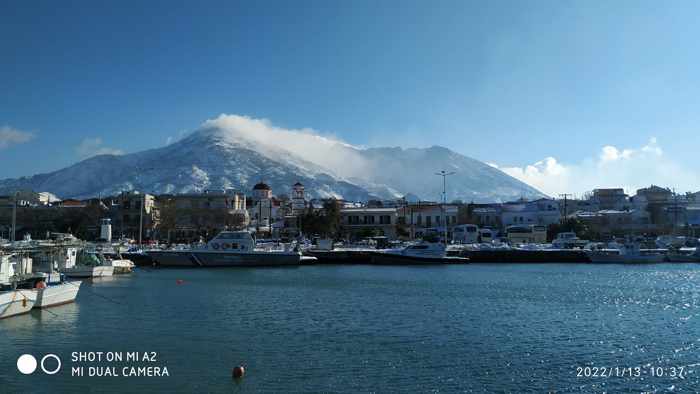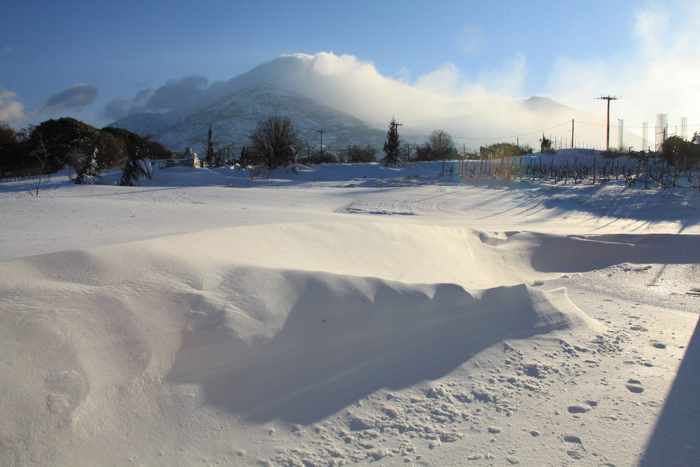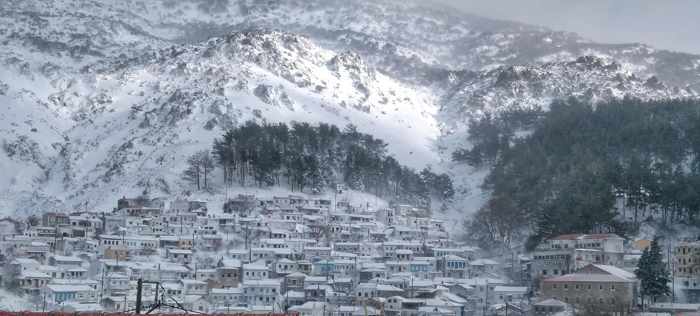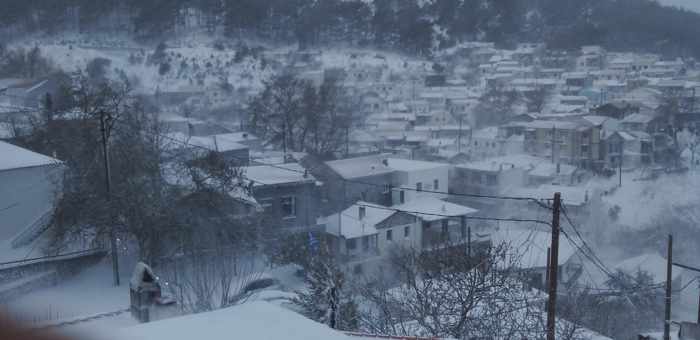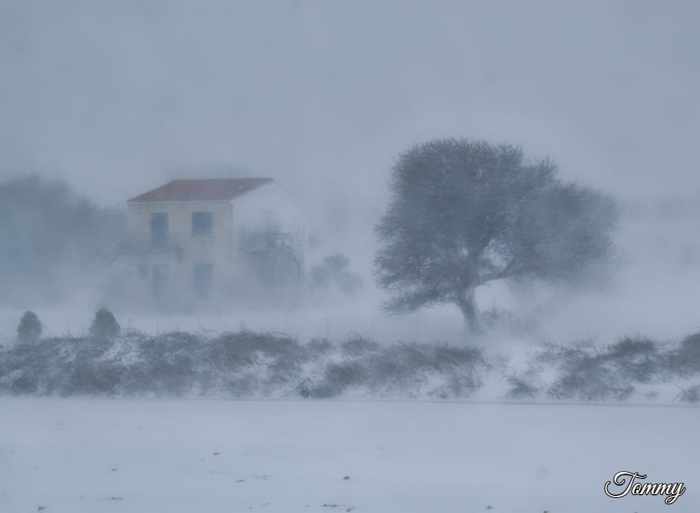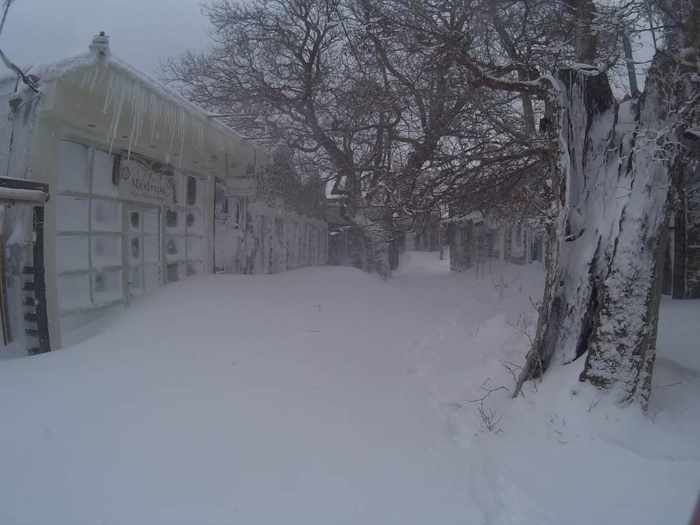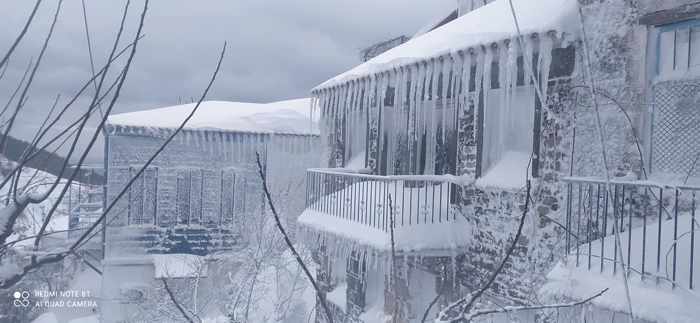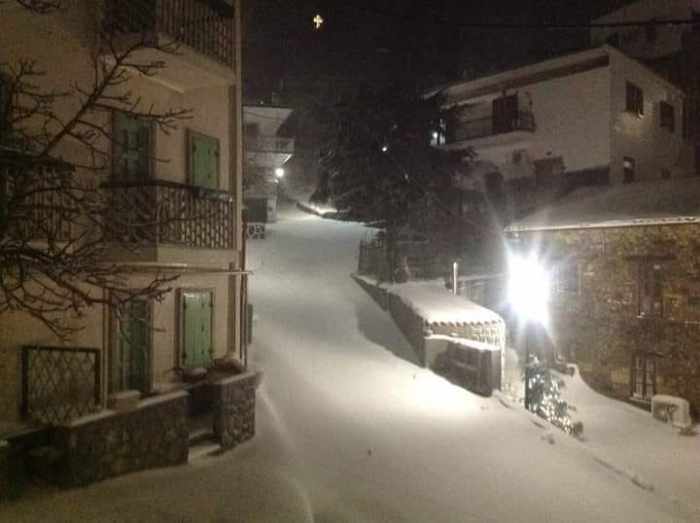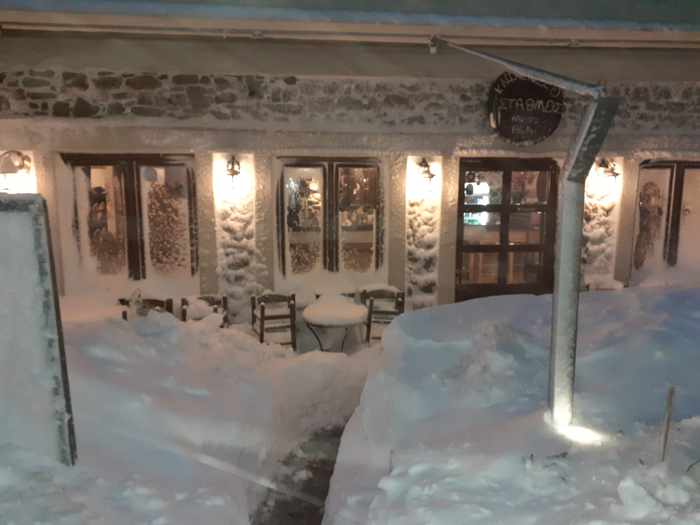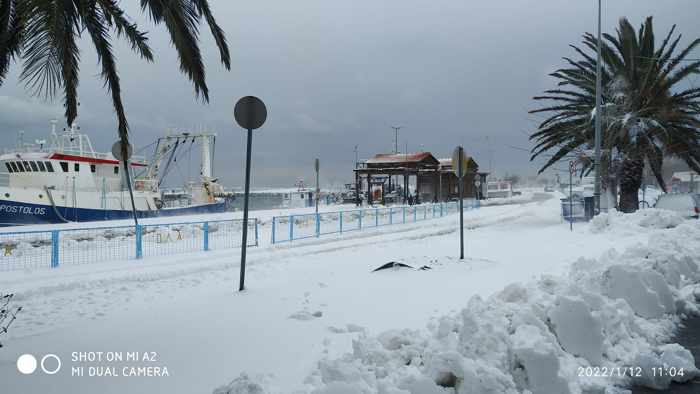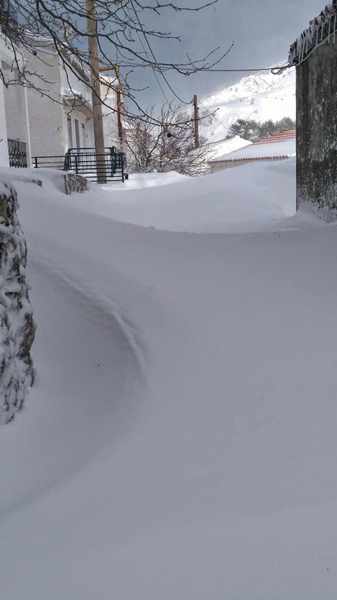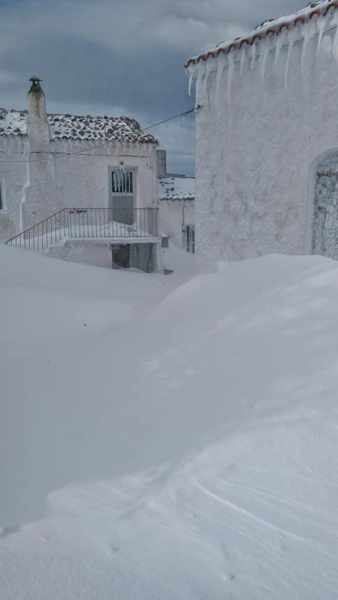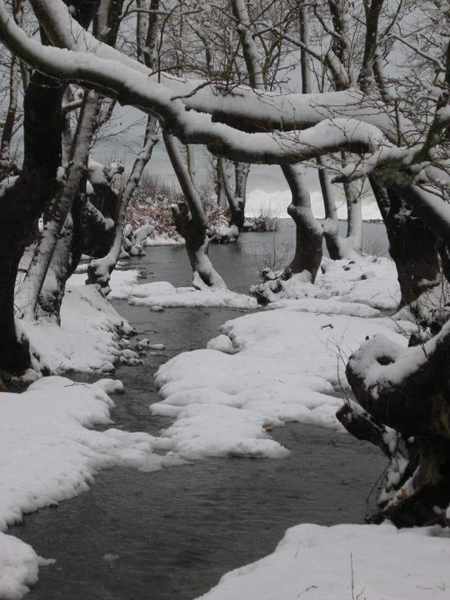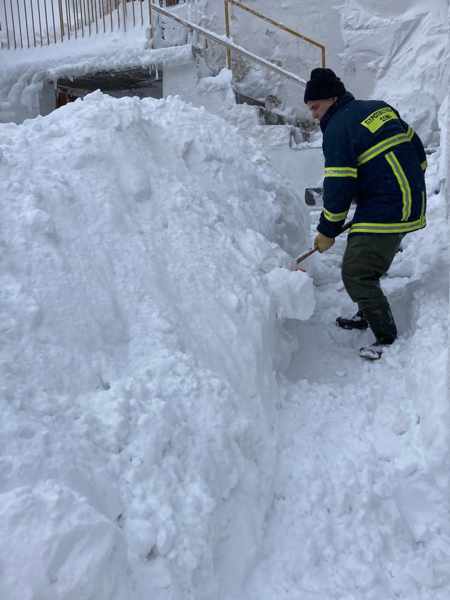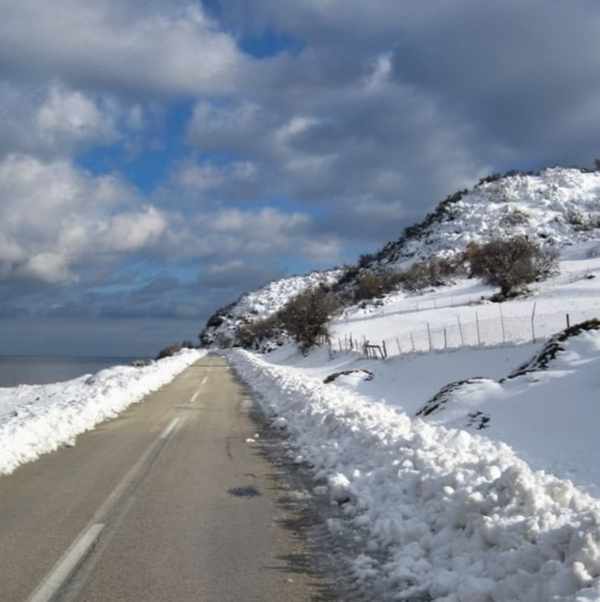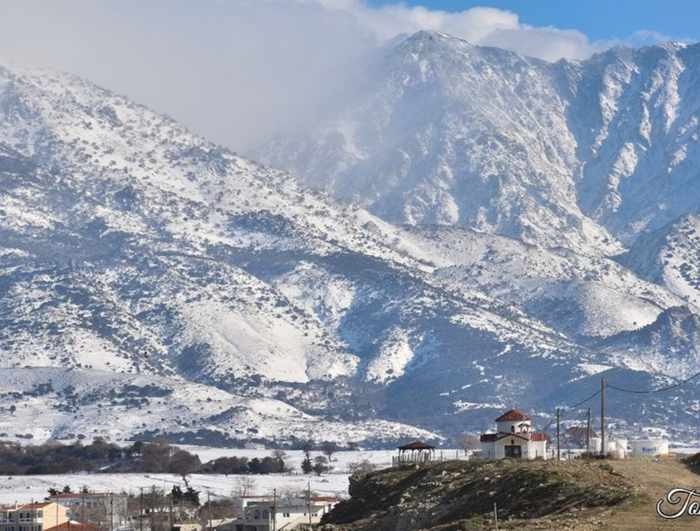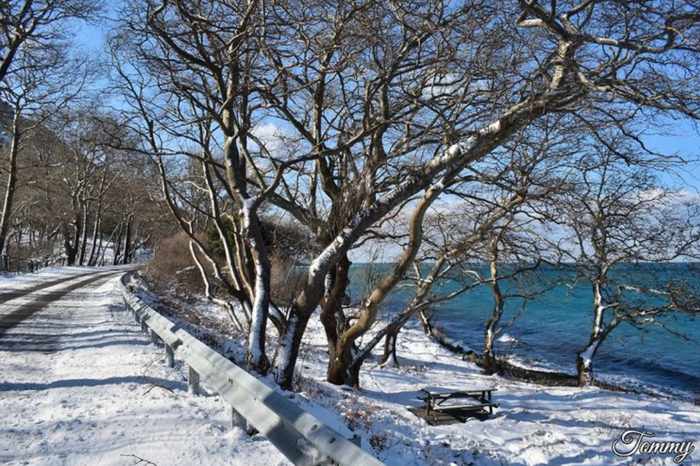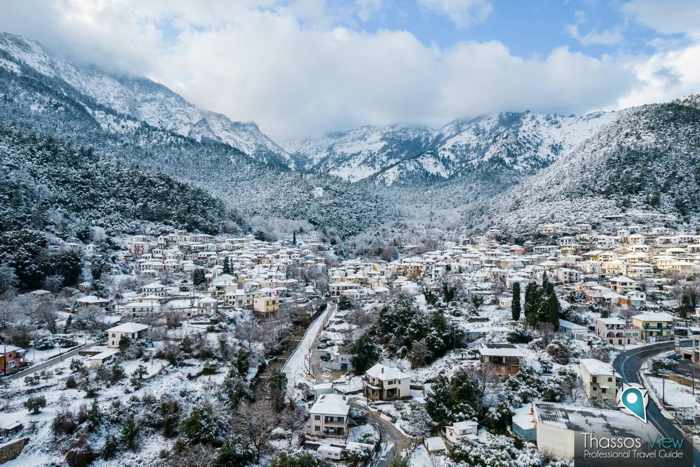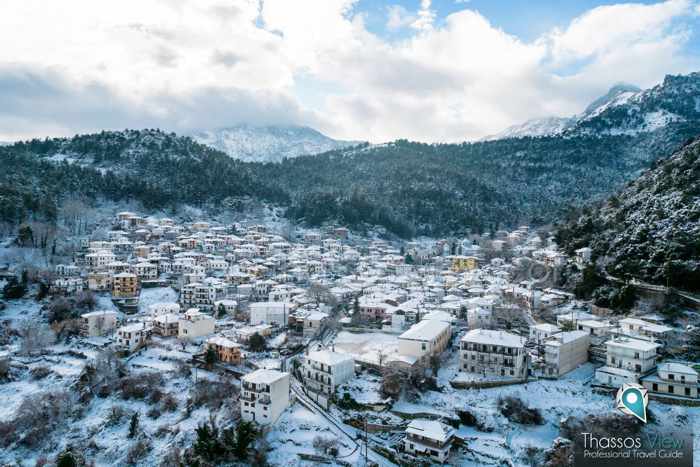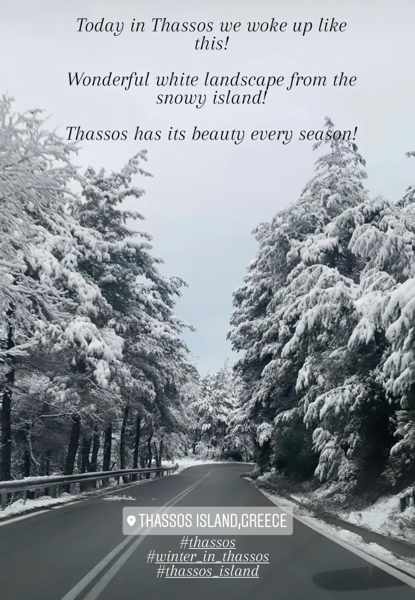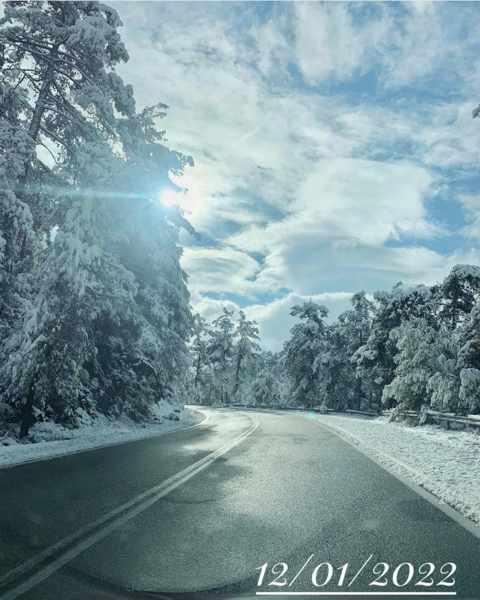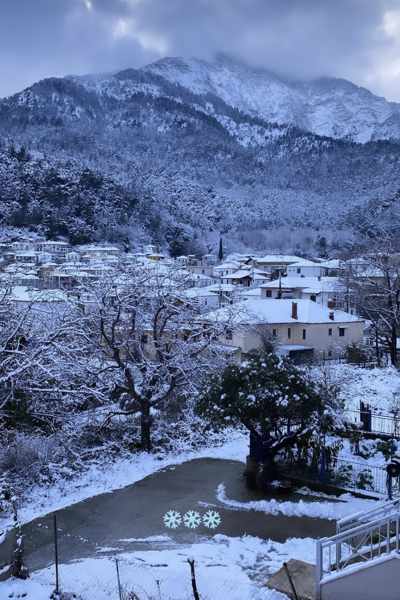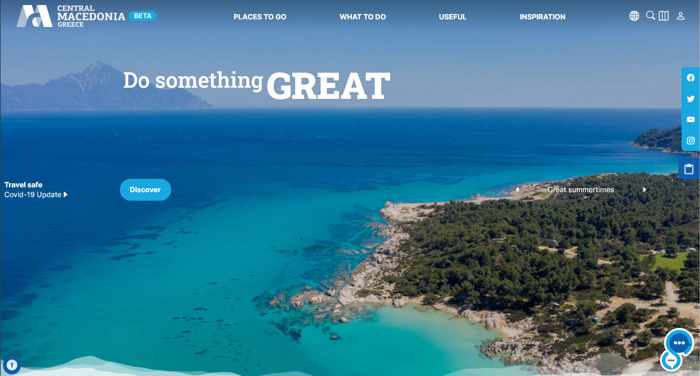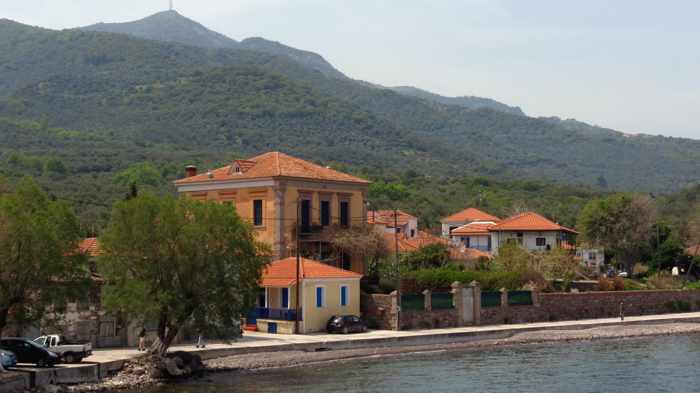

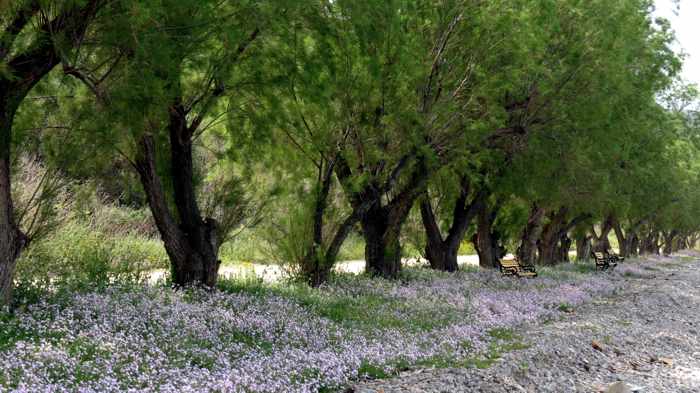
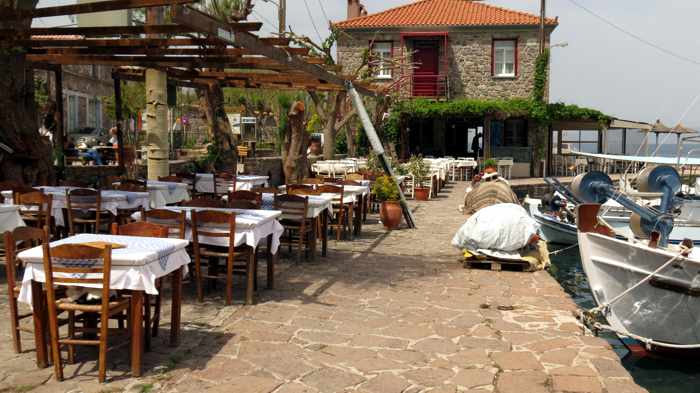
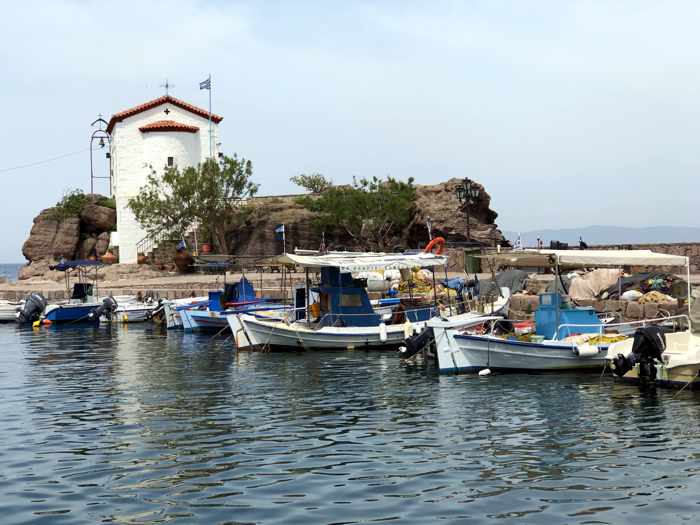
Scenes from our visit to Skala Sykaminias village on Lesvos. From the top: Verdant mountainsides rise behind the village; a man relaxes on a bench near the fishing boats; spring wildflowers blanket the ground beneath a row of trees along the coast; harbourside tables at I Mouria Tou Mirivili taverna; fishing boats moored below the landmark church of Panagia Gorgona (the Mermaid Madonna).
“Skala Sykaminias is easily the most picturesque fishing port on Lesvos.” — The Rough Guide to the Dodecanese and East Aegean Islands (2005).
Seaside walkabout: We have rather hazy memories of the several hours we spent exploring scenic Skala Sykaminias village on Lesvos island during our last trip to Greece.
Just to be clear: by “hazy,” we aren’t suggesting we over-indulged in ouzo at one of the village’s portside cafes (we actually didn’t have anything to drink) — we’re referring to the lackluster sky and sunlight conditions that prevailed on that particular afternoon.
Either by sheer bad luck or complete coincidence, we had arrived in Greece four days earlier just as winds from the Sahara desert swept across the Mediterranean Sea and clouded the skies above Greece with minute particles of sand and dust.
At Cape Sounion, where we spent the first two nights of our holiday, the dusty atmosphere dulled the day-time light, muted the normally vibrant colours of the sea, sky and landscapes, and obscured the breathtaking views from the historic Temple of Poseidon. We had been hoping to experience one of the glorious Sounion sunsets we have seen pictured on Greece travel guides and postcards, but we couldn’t catch either a fleeting glimpse of the sun or its golden light; thanks to the dust, it was completely invisible.
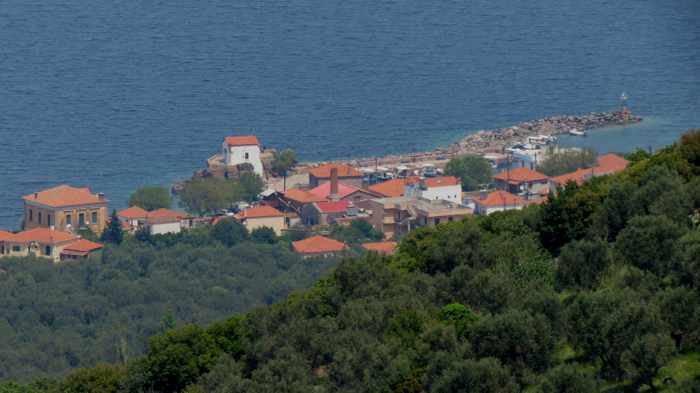
A glimpse of Skala Sykaminias village, from a lookout point along the highway from Molyvos to Mantamados
From Sounion we travelled to the town of Molyvos in northern Lesvos, hoping for clear skies and bright sunshine there. No such luck — the sky looked just as leaden, and the sun remained as elusive, as both had been back on the mainland. Our pleas for better weather were either not received or blatantly ignored by Zeus, the Greek god of the sky, because the haze persisted almost the entire week, including the day we drove to Skala Sykaminias to take a look at what’s considered to be the prettiest fishing harbour on the island, and one of the most charming in the entire country.
The village still looked lovely, of course, but we couldn’t help but feel a little let down that we weren’t experiencing its full visual beauty — with brilliant and clear blue skies, the vibrant turquoise hues of the Aegean Sea, and the vivid colours of fishing boats, flowers and foliage.
There were occasional moments when the sky suddenly seemed brighter and more clear, but those were merely a tease — the sunny periods were short-lived. But those brief breaks of brightness did give us a good impression of just how stunning Skala Sykaminias would look on a completely clear day. Admittedly, we do feel a bit of jealousy when we see crisp, clear and richly colourful photos of the village on Instagram and other social media. But those also make us look forward to a paying a return visit some day, hopefully under more auspicious weather conditions.
So, what was there to see at Skala Sykaminias on that hazy April afternoon?
The village was pleasantly quiet and peaceful, with probably no more than three dozen people out and about — including local residents and a small clutch of daytrippers, like us. We weren’t expecting crowds, though, since the summer tourist season hadn’t yet begun, and Greek Easter celebrations were still a few days away.
The village cafes and tavernas
Several cafes were open for business, including two that had placed chairs and painted tables right at the harbour’s edge. At Traverso Cafe, a young couple relaxed with coffees while their daughter eagerly tucked into a luscious chocolate crepe. At Kavos Cafe, staff were busy performing maintenance chores and setting up the seaside bar patio while the cafe’s mascot, a multilingual scarlet macaw named Dias, supervised their work.
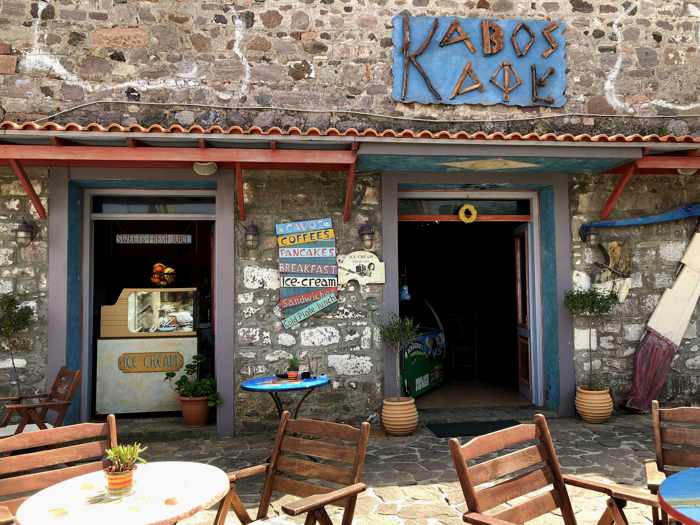
The harbour-facing side of Kavos Cafe
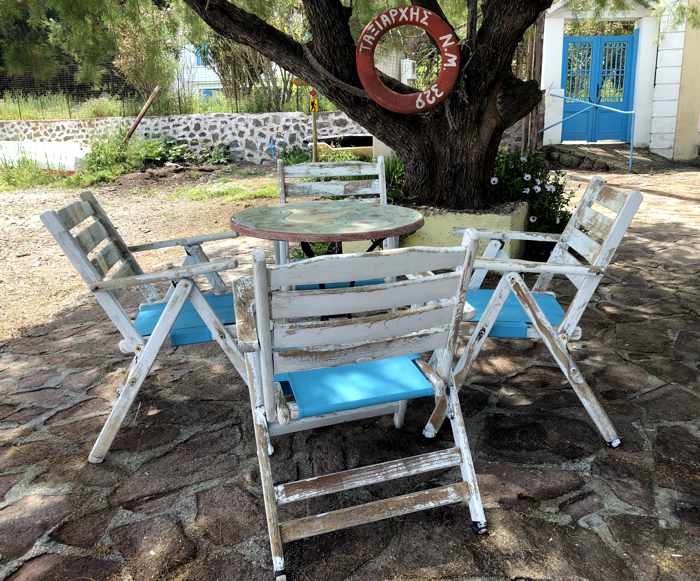
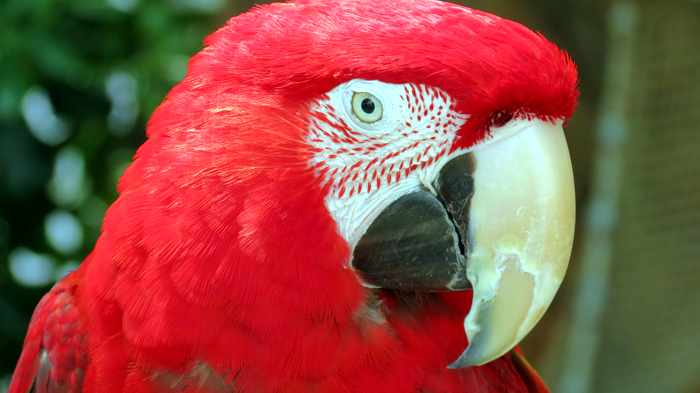
Above: a table on the back patio of Kavos Cafe, and Dias, the restaurant’s resident macaw
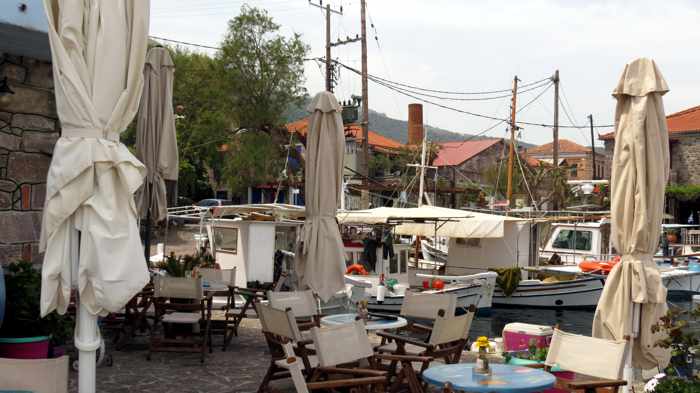
Cafe tables line the harbour’s edge in front of Kavos Cafe and Traverso Cafe

The hand-painted sign at Traverso Cafe depicts a sailboat arriving at Skala Sykaminias
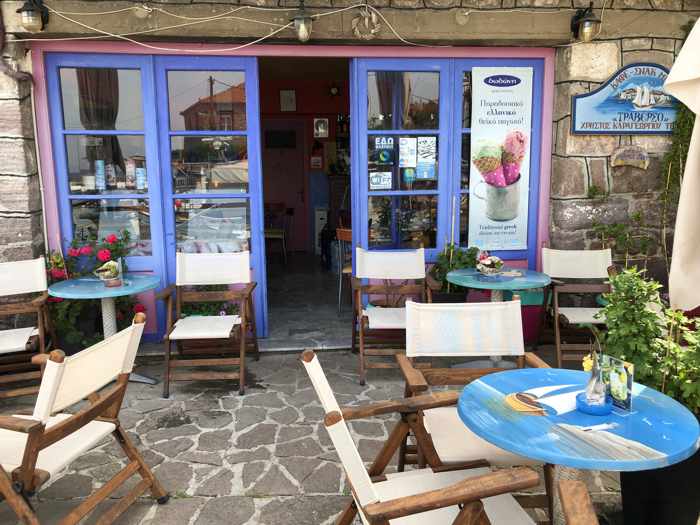
Tables on the patio at the front of Traverso Cafe
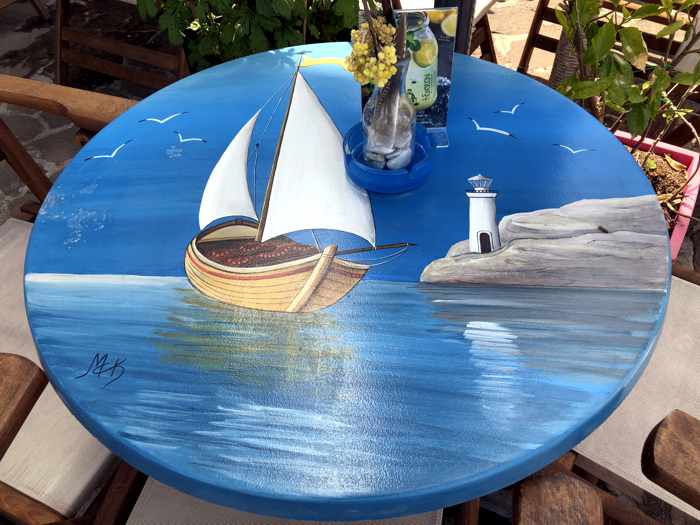
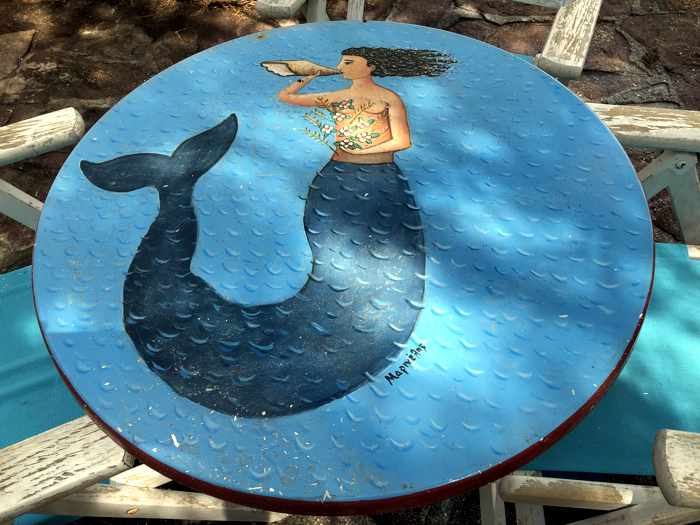
Above: two of the beautifully painted tables at the Kavos and Traverso cafes. Images of mermaids adorned several tabletops at both cafes, artistically acknowledging the Panagia Gorgona (Mermaid Madonna) church and local lore about the village’s encounters with the mythical sirens of the sea.
At the nearby taverna I Mouria Tis Mirivili, we saw two long rows of tables readied for dinner time customers, along with some of the seafood delicacies awaiting them — octopus tentacles dangling from a line, and crustaceans crawling inside a large glass tank. The taverna is probably the most well-known eatery on the island, since it’s reputedly where noted Greek novelist Stratis Myrivilis would sit and write, under the shade of what is now a 130-year-old mulberry tree, while enjoying views of the village landmark, the Panagia Gorgona church. (The restaurant name translates as “Mirivili’s Mulberry.” You can read more about both the writer and the legendary church in our post The Mermaid Madonna church at Skala Sykaminias on Lesvos.)
Next door, Anemoussa Restaurant wasn’t yet open, but several octopus were hung from a line strung above the shoreside where the taverna sets up tables and chairs when it’s operating.
Also open for shopping and browsing were a mini market, Art Shop Niki at the village square, and a craft and jewellery shop beside Kavos cafe.

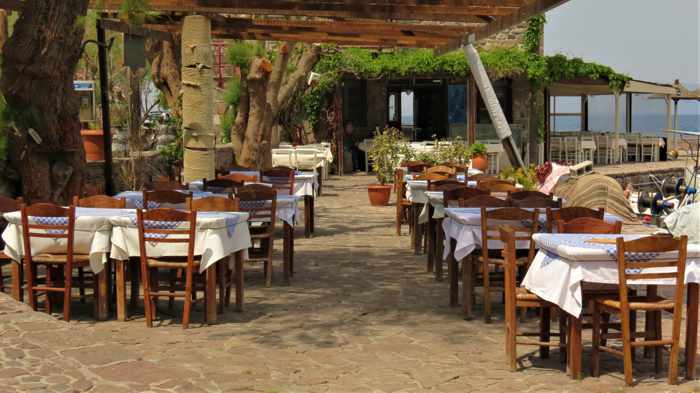
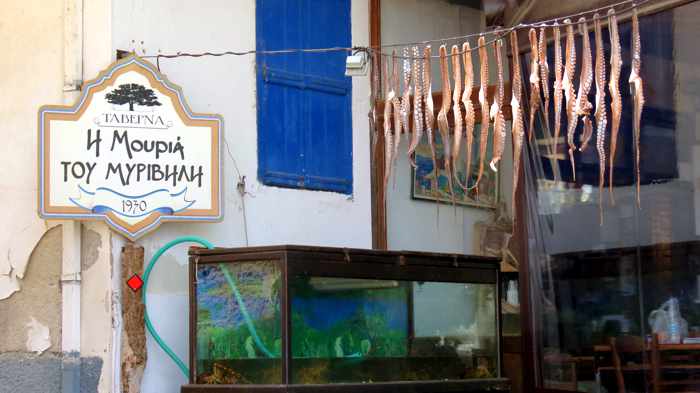
Above: I Mouria Tou Myrivili taverna, where customers can watch the fishing boats and admire Panagia Gorgona church while dining on fresh fish, seafood and traditional Greek cuisine.


Above: Octopus hang on a line near Anemoussa restaurant, while tourists browse the jewellery and craft displays at Art Shop Niki. Below: photos of the central square and some of the village houses and buildings.
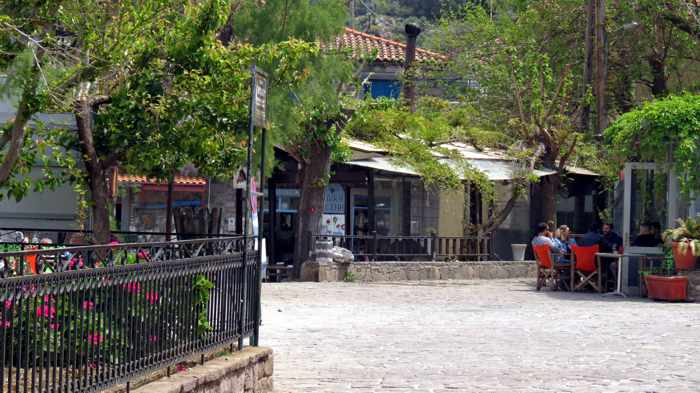

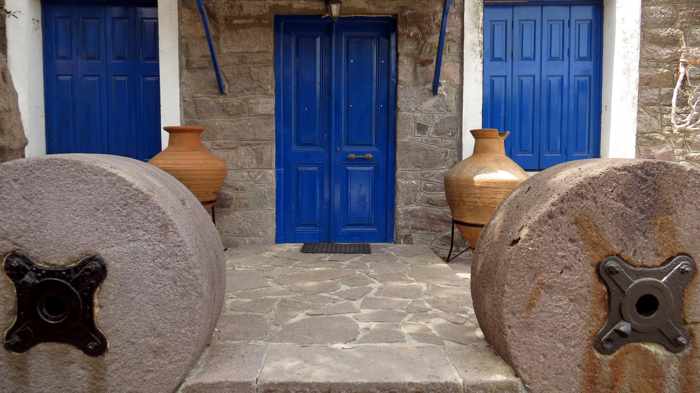
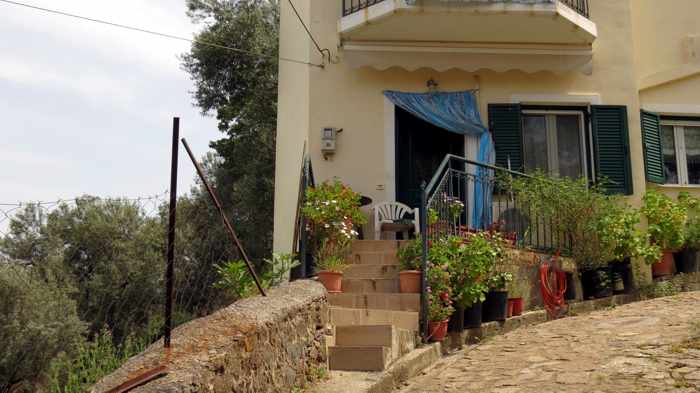
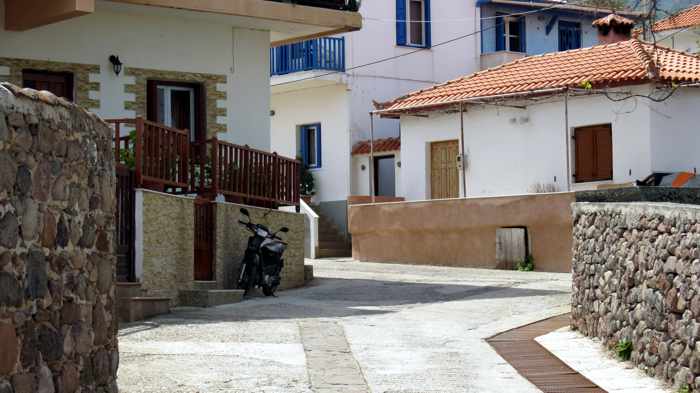
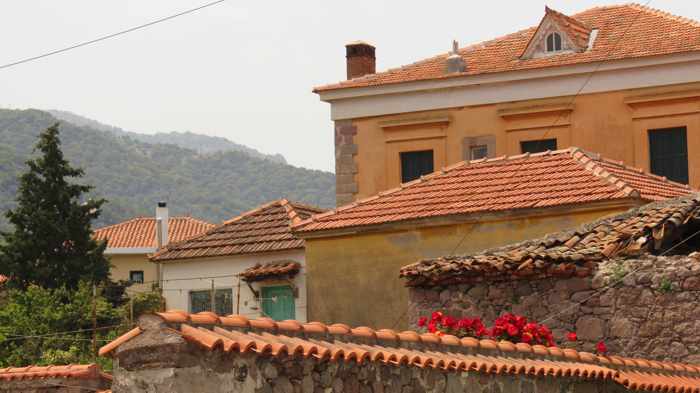
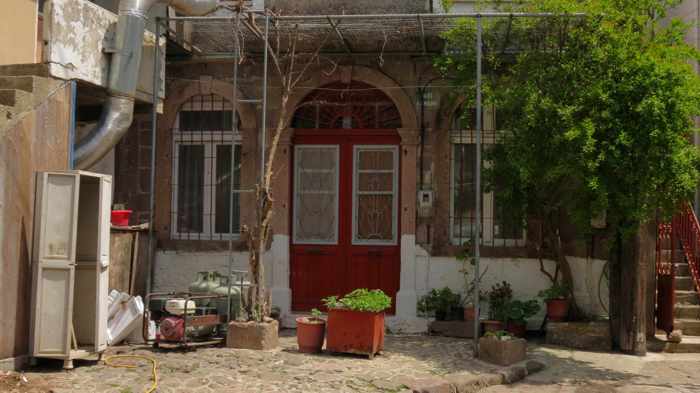
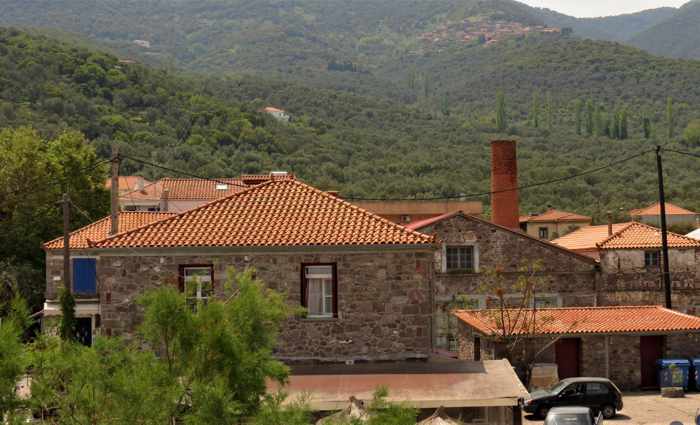
The iconic harbour
Next up was a stroll around the Skala Sykaminias harbour, which travel guidebooks and tourist brochures say is the prettiest on the island. With an array of fishing and motor boats moored in the U-shaped port, and the gleaming white Panagia Gorgona church standing sentry on a large rock next to the mole, the harbour certainly appears as charming and picturesque as the travel guides claim.
On this afternoon, it was as serene as the rest of the village. The water was calm and there wasn’t any maritime traffic — no boats coming into or leaving the port, at least not while we were there. We saw four fishermen chatting as they mended nets and worked on their adjacent vessels, a few tourists strolling along the pier, and a local man sitting on one of the harbourside benches, but that was as crowded as it got. Even the Panagia Gorgona was relatively undisturbed, with just a handful of people climbing its stairs to look at the church and enjoy its port, sea and village vistas.
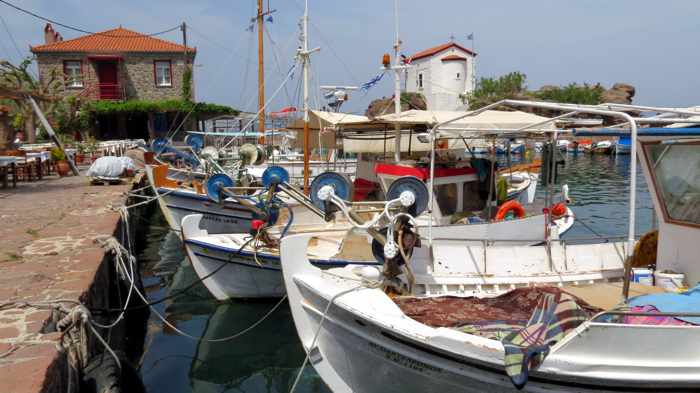
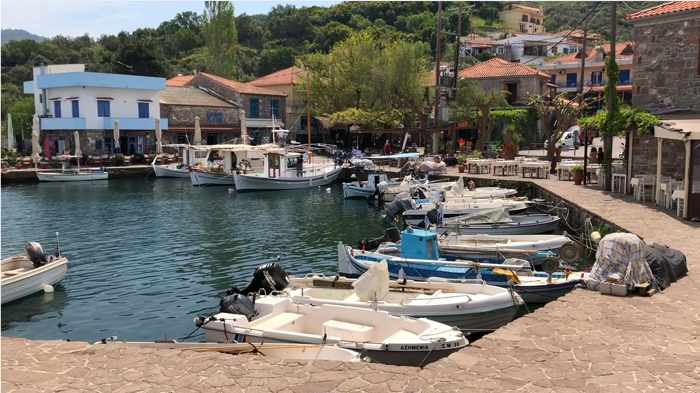
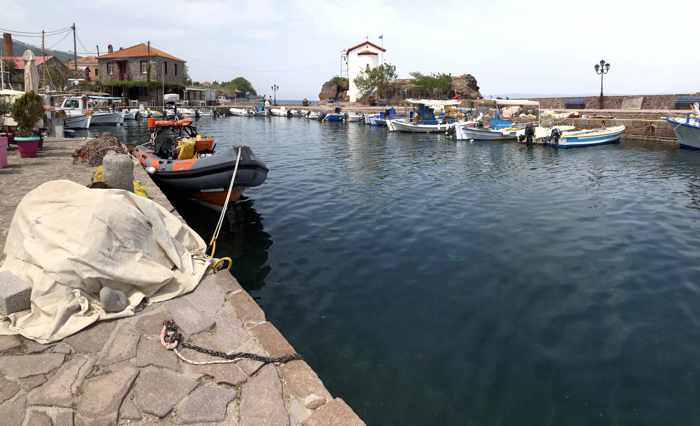
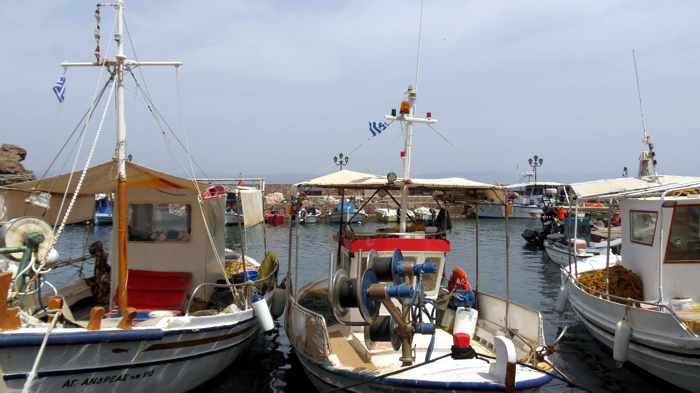
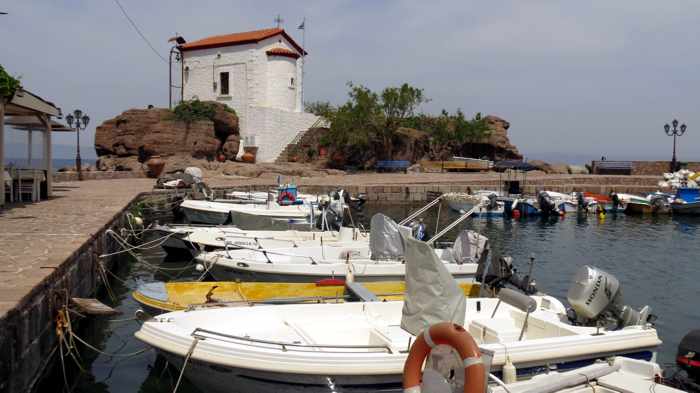
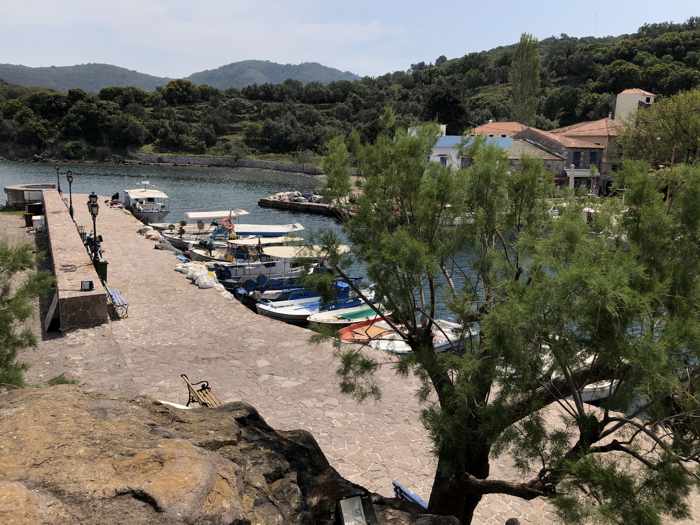
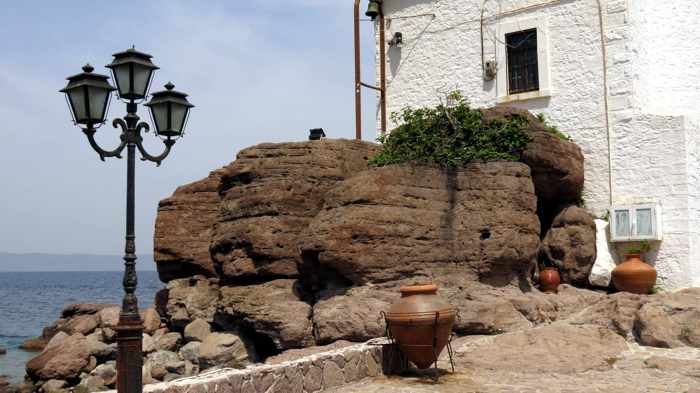
Above: Various views of the harbour, fishing boats and Panagia Gorgona church
Along the coast road
After a meandering stroll around the village and harbour, we took a long walk down a road that winds along the coast to Eftalou, the location of a popular thermal spring near Molyvos. Just outside the village, a long line of trees separates the road from the rocky shoreline. Benches provide shaded spots to relax and gaze at the sea and the distant coast of Turkey; underfoot, the ground was covered with white and pink wildflowers. We walked about 45 minutes before retracing our steps to the village. We had the road all to ourselves most of the time, seeing only three other people — one man walking, two others driving vehicles — during our trek.
Had we continued a couple kilometers farther, we could have seen a natural hot spring which we later learned about while reading the Skala Sykaminias page on the molyvos.eu website. Based on a map the website provided to pinpoint the spring’s location, we figure we had walked more than halfway there before turning around.
Below are some of the photos we took along the way.
